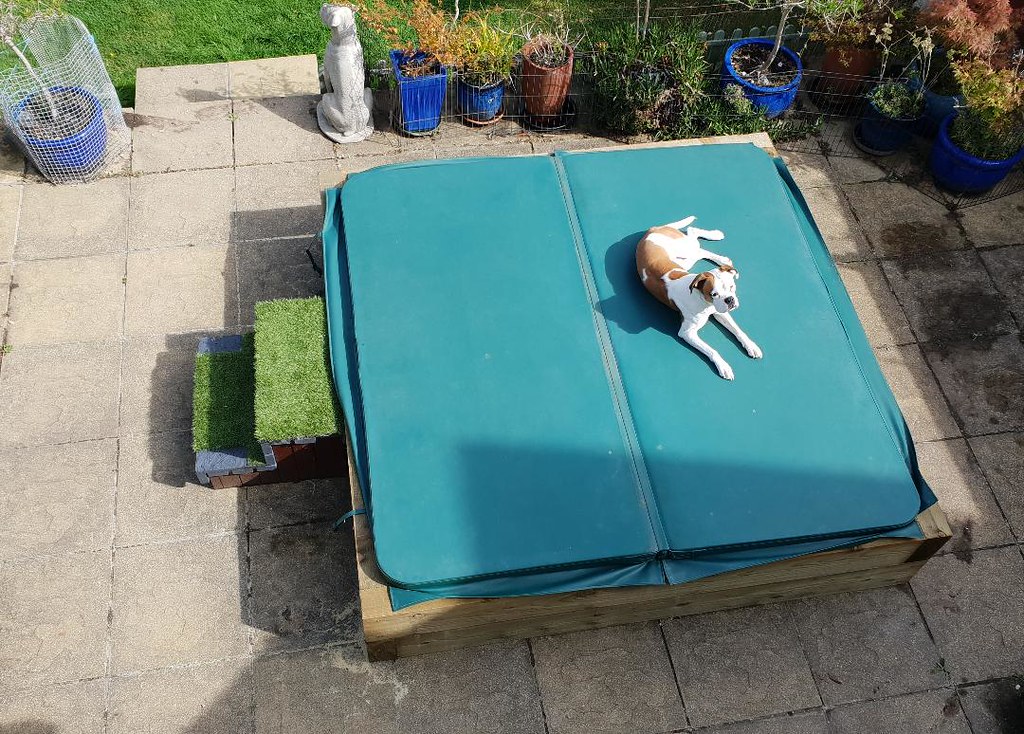How to Choose the Best Hot Tub Covers for Your Spa…

This page contains ebay affiliate links. I may earn a commission for qualified purchases at no additional cost to you. These links are marked (AD)
If you own a hot tub ↗ (AD), you know how important it is to keep it clean and well-maintained. One of the most essential accessories for your spa is a hot tub cover ↗ (AD). A good cover can protect your hot tub from dirt, debris, weather, and unwanted guests. It can also help you save energy and money by reducing heat loss and evaporation.
But how do you choose the best hot tub cover for your spa? There are many factors to consider, such as size, shape, material, insulation, durability, and price. In this article, we will guide you through the process of finding the perfect cover for your hot tub. We will also give you some tips on how to care for your cover and extend its lifespan.
What are the benefits of hot tub covers?
Hot tub covers have many benefits for your spa and your wallet. Here are some of the main advantages of using a hot tub cover:
- They keep your water clean and clear. A cover prevents leaves, insects, dirt, and other contaminants from entering your spa. This reduces the need for chemicals ↗ (AD) and filters ↗ (AD), and improves the water quality and hygiene.
- They prevent heat loss and evaporation. A cover acts as a barrier between the water and the air, trapping the heat inside the spa. This reduces the amount of energy needed to heat the water, and lowers your electricity bills. A cover also prevents water from evaporating, which means less water waste and less need to refill the spa.
- They protect your spa from damage. A cover shields your hot tub from UV rays, rain, snow, hail, wind, and other elements that can cause fading, cracking, or warping. A cover also protects your spa from animals or children who might accidentally fall into it or damage it.
- They enhance your spa experience. A cover can make your hot tub more comfortable and inviting. It can block out noise and light pollution, creating a more relaxing and private atmosphere. It can also add to the aesthetic appeal of your spa, especially if you choose a colour and design that matches your outdoor décor.
What are the types of hot tub covers?
Hot tub covers come in different shapes, sizes, and materials. The most common types are:
- Hard covers ↗ (AD). These are the most popular and durable covers for hot tubs. They are made of rigid foam boards covered with vinyl or other fabrics. They usually have hinges or straps that allow you to fold them in half or in quarters for easy removal and storage. They also have locks or clips that secure them to the spa.
- Soft covers ↗ (AD). These are lighter and cheaper than hard covers, but less sturdy and insulating. They are made of flexible materials such as vinyl, polyester, or nylon. They usually have elastic edges or drawstrings that fit snugly around the spa rim. They are easy to put on and take off, but they may sag or tear over time.
- Roll-up covers ↗ (AD). These are similar to soft covers, but they have a mechanism that allows you to roll them up like a carpet or a mat. They are made of foam or vinyl strips that are attached to a metal or plastic rod. They are convenient and space-saving, but they may not provide enough insulation or protection for your spa.
- Thermal blankets ↗ (AD). These are not really covers, but thin layers of insulation that float on top of the water surface. They are made of bubble wrap or reflective foil that trap heat and prevent evaporation. They are usually used in conjunction with hard or soft covers to enhance their performance.
What are the features to look for in hot tub covers?
When choosing a hot tub cover, you should consider several features that affect its quality and performance. Here are some of the most important ones:
- Size and shape. Your cover should fit your spa perfectly, leaving no gaps or spaces where heat or dirt can escape or enter. You should measure your spa carefully before buying a cover, taking into account its length, width, height, corners, curves, and cut-outs. You can choose a standard size cover that matches your spa dimensions, or order a custom-made cover that fits your spa exactly.
- Material and colour. Your cover should be made of durable and weather-resistant materials that can withstand exposure to sun, rain, snow, wind, chemicals, and temperature changes. You should also choose a colour that suits your taste and outdoor décor. Some common materials and colours for hot tub covers are:
- Vinyl: This is the most common material for hard covers. It is strong, waterproof, UV-resistant, and easy to clean. It comes in various colours and patterns, such as solid colours (blue, green, brown), marble effects (grey, white), or woodgrain effects (oak, walnut).
- Polyester: This is a common material for soft covers. It is lightweight, breathable, fade-resistant and mildew-resistant.
It comes in various colours and prints, such as solid colours (black, red, yellow), floral designs (pink, purple, orange), or geometric shapes (stripes, dots, squares). - Nylon: This is another material for soft covers. It is similar to polyester, but more durable and abrasion-resistant. It comes in various colours and textures, such as solid colours (navy, burgundy, beige), mesh effects (black, white, grey), or quilted effects (cream, tan, khaki).
- Insulation and R-value. Your cover should have enough insulation to keep your spa water warm and reduce heat loss. The insulation is usually made of foam boards that vary in thickness and density. The R-value is a measure of how well the insulation resists heat flow. The higher the R-value, the better the insulation. The R-value of hot tub covers ranges from 3 to 20, depending on the type and quality of the foam. You should choose a cover with a high R-value that suits your climate and spa usage. For example, if you live in a cold area or use your spa frequently, you may need a cover with an R-value of 15 or higher. If you live in a mild area or use your spa occasionally, you may need a cover with an R-value of 10 or lower.
- Durability and warranty. Your cover should be able to last for several years without breaking, tearing, or fading. You should check the quality of the materials and the craftsmanship of the cover before buying it. You should also look for a cover that comes with a warranty that covers defects or damages caused by normal wear and tear. The warranty period of hot tub covers varies from 1 to 10 years, depending on the manufacturer and the model. You should choose a cover with a long warranty that gives you peace of mind and value for money.
What are some ancillary items for hot tub covers?
Besides the cover itself, you may also need some ancillary items that can enhance the functionality and appearance of your cover. Some of these items are:
- Cover lifters ↗ (AD). These are devices that help you lift and store your cover easily and safely. They are usually attached to the side or the base of your spa, and they use hydraulic or mechanical mechanisms to raise and lower your cover. They can save you time and energy, as well as prevent injuries or damages to your cover.
- Cover cleaners ↗ (AD). These are products that help you clean and maintain your cover regularly. They are usually sprays or wipes that remove dirt, stains, moulds, or odours from your cover. They can also protect your cover from UV rays, water spots, or chemical residues.
- Cover caps ↗ (AD). These are extra layers of protection that you can put over your cover when not in use. They are usually made of plastic or fabric that shield your cover from dust, debris, snow, ice, or bird droppings. They can also prevent fading or cracking caused by sun exposure.
How to care for your hot tub cover?
To keep your hot tub cover in good condition and extend its lifespan, you should follow some simple steps:
- Clean your cover regularly. You should wipe off any dirt or debris from your cover with a soft cloth or a sponge every week. You should also spray or wipe your cover with a cover cleaner every month to remove any stains or odours.
- Rinse your cover thoroughly. You should rinse off any soap or chemical residues from your cover with clean water every time you clean it. You should also rinse off any snow or ice from your cover during winter to prevent freezing or cracking.
- Dry your cover completely. You should dry off any moisture from your cover with a towel or a hairdryer every time you rinse it. You should also air out your cover every few weeks to prevent moulds or mildews from growing inside the foam.
- Store your cover properly. You should store your cover in a cool and dry place when not in use. You should also use a cover lifter or a helper to lift and store your cover safely and gently.
- Replace your cover when needed. You should replace your cover when it shows signs of wear and tear, such as tears, holes, sagging or fading.
You should also replace your cover when it loses its insulation ability, such as when it becomes too heavy, wet or cold.
Disclaimer: This article is for informational purposes only and does not constitute professional advice. Please consult with a qualified hot tub dealer or technician before buying or using any hot tub covers or ancillary items.

